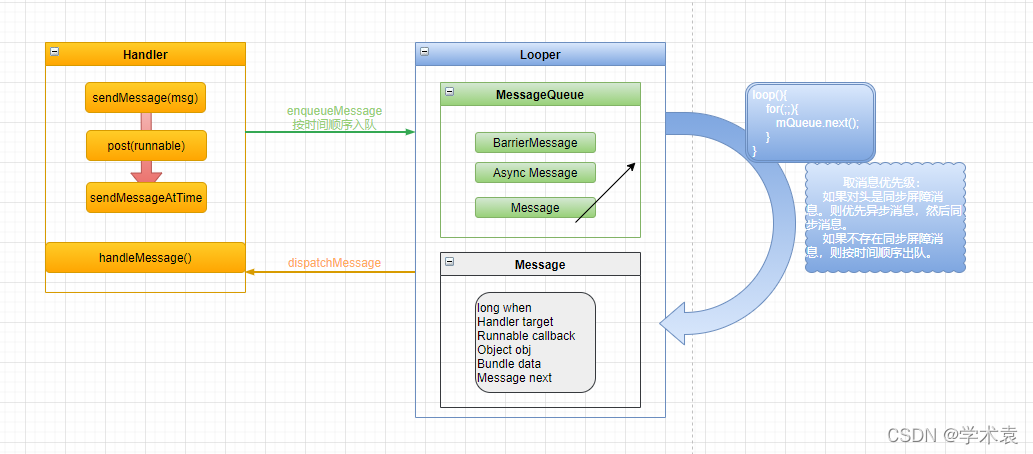文化袁探索专栏——Activity、Window和View三者间关系
文化袁探索专栏——View三大流程#Measure
文化袁探索专栏——View三大流程#Layout
文化袁探索专栏——消息分发机制
文化袁探索专栏——事件分发机制
文化袁探索专栏——Launcher进程启动流程’VS’APP进程启动流程
文化袁探索专栏——Activity|Application启动流程
文化袁探索专栏——自定义View实现细节
文化袁探索专栏——线程安全
文化袁探索专栏——React Native启动流程
消息分发机制,必定离不开Handler、Looper、MessageQueue三者间关系;
关系: 一个线程之多有一个Looper;一个looper有一个MessageQueue;而一个MessageQueue对应了多个message;一个MessageQueue对应多个Handler。
先引出一个问题——为什么非静态类的 Handler 导致内存泄漏?如何解决?
非静态内部类、匿名内部类、局部内部类等,都会隐士的持有其外部类的引用。即若在Activity中创建了非静态Handler,那么会由此持有Activity的引用。当非静态Handler使用在主线程时,会默认绑定该线程的Looper对象,并关联它的MessageQueue,Handler发出的消息都会enQueue到MessageQueue消息队列中。(Looper对象的生命周期贯穿主线程整个生命周期)。当消息队列MessageQueue中还有未处理完的message消息时,因为每个message都持有Handler引用,handler无法被回收。同时handler持有的外部类Activity引用也无法回收,从而造成了泄露。
解决方案:使用静态内部类 + 弱引用方式
消息分发原理

发送消息
/**1.直接在Runnable中处理任务*/
handler!!.post(Runnable { ... }) //message.callback.run(),优先级最高
/**2.直接在Callback中接收处理任务*/
val handler = object:Handler(Callback{...})
/**3.直接在handleMessage中接收处理任务*/
val handler = object:Handler(){
override fun handleMessage(msg: Message) {
super.handleMessage(msg)
}
}
/**
* Handle system messages here.
*/
public void dispatchMessage(@NonNull Message msg) {
if (msg.callback != null) {
handleCallback(msg); // 优先级第一
} else {
if (mCallback != null) {
if (mCallback.handleMessage(msg)) {// 优先级第二
return;
}
}
handleMessage(msg);// 优先级第三
}
}
// 在这里发送消息有两种方式
// 1, handler.post*(Runnable)
// 2, handler.send*Message*(Message)
消息发送方式有有两种:handler.post开头的消息发送方法,和handler.send开头的消息发送方法。
handler.post和handler.send发送消息的区别?
以handler.send开头的消息发送方法,直接发送Message消息,通过调用sendMessageAtTime方法,最终调用消息入队方法enqueueMessage。处理消息时,在dispatchMessage 中优先级会低于 handleCallback(msg) 方法。
以handler.post开头的消息发送方法,Runnable最后会被封装成 Message 对象(Message.callback=runnable)。然后通过调用sendMessageAtTime方法,最终调用enqueueMessage将消息入队方法队列。只是在处理消息时,会在 dispatchMessage() 方法里首先被 handleCallback(msg) 方法执行。
在发送消息的时候,虽然都调用了sendMessageAtTime方法。好像是延迟**时间后发送,其实则是直接将发送的消息入队,并没有延迟。而真实延迟是在消息出队过程中。
消息插入队列(enQueue)
如果新消息的被执行时间when比队列中任何一个消息都早,则插入队头。且唤醒Looper。
如果当前队头是同步屏障消息,新消息是异步消息,则唤醒Looper。
【同步屏障消息】message.target=null,这类消息不会被真的执行,它起到标记作用,MessageQueue在遍历消息队列时,如果队头是同步屏障消息,那么会忽略同步消息,优先让异步消息得到执行。正如会在MessageQueue.java中看到的这几行代码:
// MessageQueue.java
if (msg != null && msg.target == null) {
// Stalled by a barrier. Find the next asynchronous message in the queue.
// 忽略同步消息,优先让异步消息得到执行
do {
prevMsg = msg;
msg = msg.next;
} while (msg != null && !msg.isAsynchronous());
}
如果队头消息为空,或消息的when=0不需要延迟,或比队列中任何一个消息都早,则插入队列队头。否则按时间顺序,找到该消息合适的位置并插入。
// MessageQueue.java 消息入队的逻辑方法
boolean enqueueMessage(Message msg, long when) {
//普通消息的target字段不能为空,否则不知道该交由谁来处理这条消息
if (msg.target == null) {
throw new IllegalArgumentException("Message must have a target.");
}
synchronized (this) {
msg.when = when;
//mMessages始终是队头消息
Message p = mMessages;
boolean needWake;
//如果队头消息为空,或消息的when=0不需要延迟,或比队列中任何一个消息都早
//则插入队头
if (p == null || when == 0 || when < p.when) {
// New head, wake up the event queue if blocked.
msg.next = p;
mMessages = msg;
//如果当前Looper处于休眠状态,则本次插入消息之后需要唤醒
needWake = mBlocked;
} else {
//要不要唤醒Looper= 当前Looper处于休眠状态 & 队头消息是同步屏障消息 & 新消息是异步消息
//目的是为了让异步消息尽早执行
needWake = mBlocked && p.target == null && msg.isAsynchronous();
Message prev;
for (;;) {
prev = p;
p = p.next;
//按时间顺序 找到该消息 合适的位置
if (p == null || when < p.when) {
break;
}
if (needWake && p.isAsynchronous()) {
needWake = false;
}
}
//跳转链表中节点的指向关系
msg.next = p;
prev.next = msg;
}
//唤醒looper
if (needWake) {
nativeWake(mPtr);
}
}
return true;
}
Handler 实现发送延迟消息的原理是如何呢?
环境描述~
代码块中sendMessageDelayed–>>sendMessageAtTime,其中sendMessageAtTime方法参数第一个是消息本体,第二个则是要延迟发送的时间=SystemClock.uptimeMillis() + delayMillis。
uptimeMillis()表示自开机后所经过的时间,不包括深度休眠时间(如关机);currentTimeMillis()表示系统当前时间,可被修改;
public final boolean sendMessageDelayed(@NonNull Message msg, long delayMillis) {
if (delayMillis < 0) {
delayMillis = 0;
}
return sendMessageAtTime(msg, SystemClock.uptimeMillis() + delayMillis);
}
我们常用 postDelayed() 与 sendMessageDelayed() 来发送延迟消息,其实最终都是将延迟时间转为入队时间,然后通过 sendMessageAtTime() -> enqueueMessage -> queue.enqueueMessage 这一系列方法将消息插入到 MessageQueue 中。所以并不是先延迟再发送消息,而是直接发送消息,再借助MessageQueue 的设计来实现消息的延迟处理。
消息延迟处理的原理涉及 MessageQueue 的两个静态方法 MessageQueue.next() 和 MessageQueue.enqueueMessage()。通过 nativePollOnce方法阻塞线程一定时间,等到消息的执行时间到后再取出消息执行。
// // MessageQueue$next方法中
if (msg != null) {
if (now < msg.when) {
// 当Next message 还没到执行的时间,则设置nextPollTimeoutMillis=要阻塞的时间。
// msg.when = SystemClock.uptimeMillis() + delayMillis
// Next message is not ready. Set a timeout to wake up when it is ready.
nextPollTimeoutMillis = (int) Math.min(msg.when - now, Integer.MAX_VALUE);
}
... ......
消息分发
Message消息分发逻辑,在MessageQueue类中的loop方法中执行。而在分发过程中,获取消息方法queue.next并不是会无限循环的执行,还会进入阻塞。
// MessageQueue.java下loop方法执行消息分发
public static void loop() {
final Looper me = myLooper();
...
me.mInLoop = true;
final MessageQueue queue = me.mQueue;
...
for (;;) {
// 进行无限循环,.next()获取可执行的消息。其中 ‘might block’表示可能会阻塞
// 具体的进入阻塞条件,进入到MessageQueue$next()方法可观察
Message msg = queue.next(); // might block
if (msg == null) {
// No message indicates that the message queue is quitting.
return;
}
...
try {
// 执行消息分发;target为当前Handler实例
msg.target.dispatchMessage(msg);
......
}
}
Message消息分发过程中,获取消息方法queue.next如何会进入阻塞? nextPollOne其实为指代阻塞的时间,如果nextPollTimeoutMillis>0则进入阻塞状态,直到nextPollTimeoutMillis时间过后。由于第一次nextPollTimeoutMillis=0,不会阻塞。如果第一次循环就没有需要分发的消息,nextPollTimeoutMillis会更新为nextPollTimeoutMillis=-1,再次进入循环时则进入阻塞,直到有新的消息进入。
// MessageQueue.java
Message next() {
// Return here if the message loop has already quit and been disposed.
// This can happen if the application tries to restart a looper after quit
// which is not supported.
final long ptr = mPtr;
if (ptr == 0) {
return null;
}
int pendingIdleHandlerCount = -1; // -1 only during first iteration
int nextPollTimeoutMillis = 0;
for (;;) {
if (nextPollTimeoutMillis != 0) {
Binder.flushPendingCommands();
}
// 执行进入阻塞的native方法 nativePollOne
// nextPollTimeoutMillis其实是指代阻塞的时间。进入阻塞后会释放cpu资源。
nativePollOnce(ptr, nextPollTimeoutMillis);
// 当Looper被唤醒时,继续向下执行
synchronized (this) {
// Try to retrieve the next message. Return if found.
final long now = SystemClock.uptimeMillis();
Message prevMsg = null;
Message msg = mMessages;
// msg.target == null如果消息是屏障消息。则会尝试找到异步消息进行执行
if (msg != null && msg.target == null) {
// Stalled by a barrier. Find the next asynchronous message in the queue.
do {// 从循环中看,若消息是同步消息则会一直.next
prevMsg = msg;
msg = msg.next;
} while (msg != null && !msg.isAsynchronous());
}
if (msg != null) {
if (now < msg.when) {
// 当Next message 还没到执行的时间,则设置nextPollTimeoutMillis=要阻塞的时间。
// Next message is not ready. Set a timeout to wake up when it is ready.
nextPollTimeoutMillis = (int) Math.min(msg.when - now, Integer.MAX_VALUE);
} else {
// Got a message.找到了需要立即进行处理的消息
mBlocked = false;
if (prevMsg != null) {
prevMsg.next = msg.next;
} else {
mMessages = msg.next;
}
msg.next = null;
if (DEBUG) Log.v(TAG, "Returning message: " + msg);
msg.markInUse();
return msg;
}
} else {
// No more messages.
// 当没有消息队列中没有消息时,则nextPollTimeoutMillis 更新到-1.表示下次消息循环会进入阻塞。知道有新的消息入队。
nextPollTimeoutMillis = -1;
}
// Process the quit message now that all pending messages have been handled.
if (mQuitting) {
dispose();
return null;
}
// If first time idle, then get the number of idlers to run.
// Idle handles only run if the queue is empty or if the first message
// in the queue (possibly a barrier) is due to be handled in the future.
if (pendingIdleHandlerCount < 0
&& (mMessages == null || now < mMessages.when)) {
pendingIdleHandlerCount = mIdleHandlers.size();
}
if (pendingIdleHandlerCount <= 0) {
// No idle handlers to run. Loop and wait some more.
mBlocked = true;
continue;
}
if (mPendingIdleHandlers == null) {
mPendingIdleHandlers = new IdleHandler[Math.max(pendingIdleHandlerCount, 4)];
}
mPendingIdleHandlers = mIdleHandlers.toArray(mPendingIdleHandlers);
}
// Run the idle handlers.
// We only ever reach this code block during the first iteration.
//注册 MessageQueue.IdleHandler,可以监听当前线程的Looper是否处于空闲状态。也就意味当前线程是否处于空闲状态。
//在主线程中可以监听这个事件来做延迟初始化,数据加载,
//而不是有任务就提交,从而避免抢占重要资源。
for (int i = 0; i < pendingIdleHandlerCount; i++) {
final IdleHandler idler = mPendingIdleHandlers[i];
mPendingIdleHandlers[i] = null; // release the reference to the handler
boolean keep = false;
try {
keep = idler.queueIdle();
} catch (Throwable t) {
Log.wtf(TAG, "IdleHandler threw exception", t);
}
if (!keep) {
synchronized (this) {
mIdleHandlers.remove(idler);
}
}
}
// Reset the idle handler count to 0 so we do not run them again.
pendingIdleHandlerCount = 0;
// While calling an idle handler, a new message could have been delivered
// so go back and look again for a pending message without waiting.
//此时置为0,既然监听了线程的空闲,那么在这个
//queueIdle回调里,有可能又会产生新消息,为让消息尽可能早的得到执行。设置=0表示此时不需要休眠
nextPollTimeoutMillis = 0;
}
}





















 5515
5515











 被折叠的 条评论
为什么被折叠?
被折叠的 条评论
为什么被折叠?








